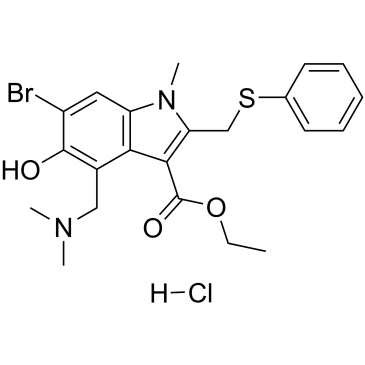| In Vitro: |
Arbidol was found to present potent inhibitory activity against enveloped and non-enveloped RNA viruses, including FLU-A, RSV, HRV 14 and CVB3 when added before, during, or after viral infection, with 50% inhibitory concentration (IC50) ranging from 2.7 to 13.8 microg/ml.However, arbidol showed selective antiviral activity against AdV-7, a DNA virus, only when added after infection (therapeutic index (TI) = 5.5) [1]. Arb interacts with the polar head-group of phospholipid at the membrane interface. Fluorescence studies of interactions between Arb and either tryptophan derivatives or membrane peptides reconstituted into liposomes show that Arb interacts with tryptophan in the micromolar range. Interestingly, apparent binding affinities between lipids and tryptophan residues are comparable with those of Arb IC50 of the hepatitis C virus (HCV) membrane fusion [2]. Arbidol not only prevented the cytopathic effect (CPE) of CVB(5), as demonstrated in an MTT colorimetric assay, when added during or after viral infection, with a 50% inhibitory concentration (IC(50)) from 2.66 to 6.62 microg/ml, but it also decreased the CVB(5)-RNA level in infected host cells, as shown in semi-quantitative RT-PCR [3]. |






















